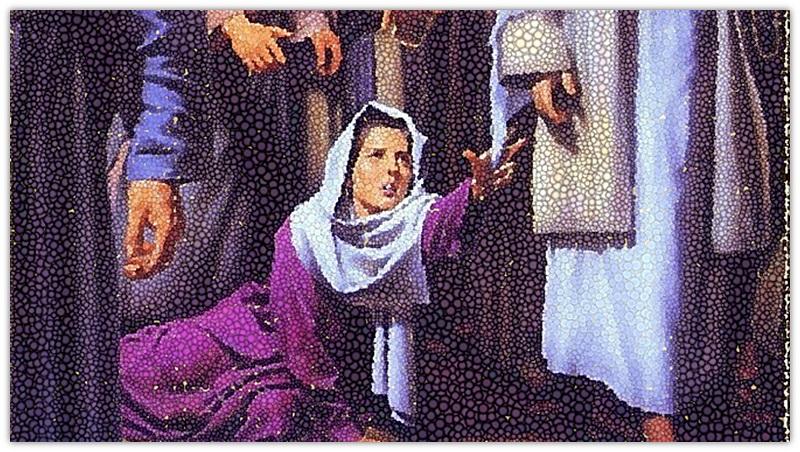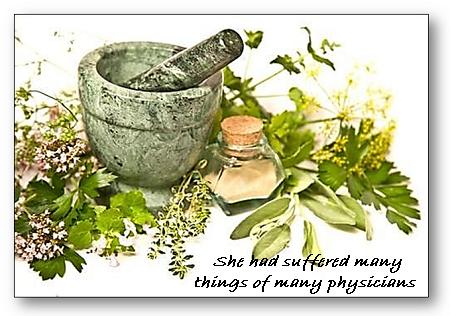The Woman with the Issue of Blood
The Woman with the Issue of Blood
Read Mark 5:25-34

This miracle took place the same time as the raising of the daughter of Jairus. Three of the Gospels give us the two miracles together. The daughter of Jairus was twelve years old, and that is exactly how long this woman had suffered. The daughter was at the point of death, and the woman was not far behind. She could have taken courage from the fact that Jesus was going with Jairus; as for Jairus, he could have taken encouragement from the fact that Jesus stopped on the way and gave someone else a complete healing. We don’t know if Jairus and the woman ever reflected on it later, but the Lord often brings people together and works so that they can take encouragement from what the Lord is doing for one another.
Meanwhile, there are many differences between Jairus and this woman. Jairus was chief of the synagogue, a public figure in his town. He walked up to Jesus and gave an eloquent request – “My little daughter lieth at the point of death: I pray thee, come and lay thy hands on her, that she may be healed: and she shall live” (v. 23). This woman, on the other hand, has no name. Considered unclean, she came from behind to reach out and press the hem of Christ’s garment and then tried to steal away quietly. Though they were so different and came so differently, Christ’s grace acted powerfully for both of them as a testimony to what His grace can do for all kinds and all sorts.
The Trouble⤒🔗
We aren’t told exactly what the disease was from which this woman was suffering, but she was bleeding day in and day out. Genesis 9:4 tells us that life is in the blood; it must have seemed like life was constantly ebbing from her. Her weak and pale complexion would have indicated that this woman was far from well.
According to Leviticus 15:25-27, she would have been shunned as well as barred from the temple. If anyone touched what she had touched, they would be unclean. How she must have wept to read Scripture’s verdict: “She shall be unclean.” From every angle, this sickness was what our passage calls “a plague” (v. 29; literally, “stroke,” or “scourge,” or “whip”).
She had tried everything for her deadly disease. There was not a physician far or near that she had not consulted. She must have originally had some means, but she had spent all her living upon hope from physicians. Mark says, “She had suffered many things of many physicians” (v. 26). The people who were to relieve suffering actually intensified it. Along with her blood, her resources were being drained, and she was no better, “but rather grew worse” (v. 26).
The Levitical requirements that God laid upon the people of Israel were to teach them the seriousness of sin. Does not sin defile us and render us unclean and vile? It saps our strength and vitality, our joy and peace, and, above all, separates us from each other and from God (see Isa. 59:2). Whatever earthly doctors we consult for help and healing, we are not better with respect to the disease of sin.
News of a greater Physician reached this woman, however (v. 27). Perhaps the report that Christ had touched the unclean leper and healed him awakens hope in her otherwise despairing heart. With her desperate need driving her on the one hand, and the report of Christ’s ability drawing her on the other, she went to Christ. Behind all of it, however, was the Father drawing this woman to the feet of His Son (John 6:44). She came to see, however faintly, a way of escape from twelve years of misery.

The Touch←⤒🔗
The woman made her way through the crowd. It was undoubtedly with stealth, but also determination. According to the text in the original language, she kept saying to herself, “If I may touch but his clothes” (v. 28). As she moved through the crowds inch by inch, she must have spotted Christ’s garments at a certain point. We know from John 19 that Christ’s outer coat was seamless, of one piece; according to the Levitical laws, the people had to mark the fringes of their garments (Num. 15:38-41). The law stipulated that they had to tie a thread of blue through the hem in order to remind them of the commandments of the Lord. By the time of Christ, this was done by attaching four tassels to the four corners of the outer garments, and weaving this blue or white thread into them.
We don’t know how much significance the woman recognized in these tassels. I doubt she could focus on the spotless purity of this obedient Son of the Father. Her regard for Christ, however, was such that she recognized that just the hem of this glorious Person could convey healing. For twelve long years, she hadn’t been allowed to touch anyone or anyone’s clothing without making that person unclean, but how inexorably she felt drawn to touch this Savior!
The word “touched” in the original refers to a determined hold, not just a passing brush. This hold effected what we read in verse 29: “straightway the fountain of her blood was dried up: and she felt in her body that she was healed of that plague.” His power reached where nothing had been effective. In a moment, the problem was cured at the source. In a moment, all the seclusion was over; all the uncleanness was gone; all the shame and separation was past.
How could Jesus do this? He could do it because Jesus had come to take care of the root problem, namely, sin. Power issued forth from Him to deal with the uncleanness issuing from her. Zechariah 13:1 had prophesied, “In that day there shall be a fountain opened to the house of David and to the inhabitants of Jerusalem for sin and for uncleanness.” Not unlike what we read in Ezekiel 16:6, His power reached her as she was there in her own blood, and said to her, “Live.”
And live she did. Gone were the days in which life was ebbing away from her – all because she had touched the hem of the Savior’s garment. This miracle proclaims to us the mediatorial power of Christ because of His dying and resurrection to deal effectively with the plague of our sin. Do we stir ourselves up to take hold of God’s Son by faith for salvation? That’s what Isaiah 64:7 refers to. Many simply crowd around Christ without taking hold of Him by faith; they do not understand their need or estimate His ability to save to the uttermost. Some have compared the promises of the gospel to the tassels that unclean sinners may take hold of – and when they do, God in Christ conveys what no other physician can: spiritual healing, restoration, and power for new life.
The Teacher←⤒🔗
The Savior healed this woman, but then He also proceeded to teach her. Verse 30 reads: “And Jesus, immediately knowing in himself that virtue had gone out of him, turned him about in the press, and said, Who touched my clothes?”
This might strike us as a strange question, especially in light of the large crowd pressing in on Christ. The disciples certainly thought it was a strange question. In fact, in Luke we read that all denied it (Luke 8:45). Yet, if Christ knew Nathanael under the fig tree and Zaccheus in the sycamore, He certainly recognized that someone had touched Him. Christ recognizes the touch of faith, and among the hundreds of people pressing Him, Jesus could sense the one believing touch among them all. This woman came secretly to Jesus and Christ had allowed it; but she would not leave secretly. Christ would not let her go quietly back to her home, only to doubt and fear whether what she had done was wrong. He would bless her further. Thus His searching question: “Who touched me?” (Mark 5:30).
This question and the words that follow were the means for the Lord to seal His work in her, the kind of thing Paul refers to in Ephesians 1:13. In this specific case, Christ did three things:
First, He saw her. Verse 32: “And he looked round about to see her that had done this thing.” It’s like the Bridegroom calling to see His bride, as we read in Song of Solomon 2:14: “O my dove, that art in the clefts of the rock, in the secret places of the stairs, let me see thy countenance, let me hear thy voice, for sweet is thy voice, and thy countenance is comely.” He calls secret believers out into the open where He can teach them and bestow more blessings on them.

Secondly, He brought her to confess Him. Paul says: “For with the heart a man believeth unto righteousness: and with the mouth confession is made unto salvation” (Rom. 10:10). Christ brought the woman to confess, even with fear and trembling. So it is every time the Lord assures and seals His power in the lives of His people.
Finally, He instructed her. Verse 34 contains much instruction for this woman and for all true believers. Every phrase is almost like a chapter heading for the Christian’s identity, life, and future. In the Old Testament, a woman like her would need to be declared clean by the priest (Lev. 15:29- 30). Here Christ is much greater than any other priest. He both healed her and declared her clean. No wonder the Bible says in Hebrews 4:15-16: “We have not a high priest who cannot be touched with the feeling of our infirmities...” Like this woman, let us go boldly to Him in the gospel, that we may obtain mercy, and find grace to help in time of need.
Questions←⤒🔗
- What are five similarities between this woman’s trouble and the convicted sinner’s trouble?
- Sometimes people are afraid of “stealing” a blessing that might not be theirs. What insight does this passage give on that, not only in the beginning but also at the end?
- In Isaiah 64:7, the prophet laments that so few stir themselves up to take hold of the Lord. What does it mean to take hold of Him, and how can this be done? How can we know that we have done so?
- Elaborate on everything the Savior teaches the woman in verse 34. How do these things parallel what the Lord teaches His people in the life of faith?
- Discuss whether there is such a thing as a secret disciple, and if so, what needs to happen to them. In addition to this miracle, consult John 19:38-39.

Add new comment